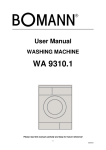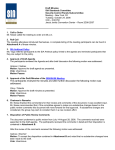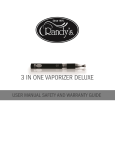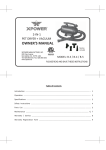Download joule retractable retarder installation & maintenance
Transcript
New Joules Engineering North America Inc. An Argent Industrial Ltd. Company JOULE RETRACTABLE RETARDER INSTALLATION & MAINTENANCE 4401 Clary Blvd., Kansas City, MO 64130 (816) 921-7441, [email protected] Fax: (816) 921-7443 Tech.-Lit. 4, Date 03/2007 The maintenance of the retractable retarder in most part is identical to the maintenance required for the standard Joule retarder. The retractable retarder utilizes the same basic hardware as the standard retarder. In addition to the standard hardware the retractable retarder is connected to a vacuum generator that creates the vacuum needed to hold the capsule in the down position. The retarder housing is connected to the vacuum generator by means of nylon tubing and pushto-lock fittings. Vacuum Generator There are two types of vacuum generators, namely air driven and electrically driven. The air driven generator utilizes compressed air to create vacuum by constantly removing the air from the pot housing. This is achieved by the venturi style pump used. The electrically driven generator utilizes a vacuum pump driven by an electrical motor to create a vacuum by constantly removing the air from the pot housing. Installation The retractable retarder housing installation is identical to the installation procedure used for the standard retarder as described in the “JOULE RETARDER INSTALLATION & SERVICE GUIDE”. Typically the retarders are mounted on both rails opposite each other. This is helpful, as the retarders can then be connected to the vacuum generator in groups. A typical group would be a pre defined number of retarders on one side of the track and the next group would be an equal amount of retarders on the opposite side of the track. This arrangement may vary. Groups of retarders Groups connected to vacuum valve. Groups connected together Vacuum line from vacuum generator Every pot housing has a swivel elbow that attaches to the pot itself via a 3/8 NPT threaded section. The opposite end of the elbow accepts the nylon tubing. Cross Section – Universal Retarder Housing w/ Retractable Configuration When installing the swivel elbow PTFE thread tape needs to be applied to the threads for proper sealing. When entering the threads care must be taken not to cross thread and damage the housing threads. Tighten the elbow snug, do not over tighten. Swivel elbow Once all the retarders are fitted to the rail and all the swivel elbows fitted to the pot housings, the housings can be connected together with the nylon tubing. The retarders are now connected in the desired groupings. The nylon tubing needs to be cut with the proper tool to prevent the tubing from “collapsing” or being pressed oval by the cutting force of the tool. A good sharp tool is best. A clean square cut is required to ensure that the tube end will enter the fitting properly and that it will bottom out in the fitting well beyond the sealing o-ring inside the fitting. To connect the tubing to the fitting, push the tubing into the fitting until resistance is felt. Push the tube in further until it can go no deeper. The resistance is caused by the o-ring as the tubing enters it. The tube will stop against the fitting’s internal shoulder. It is important to ensure that the tube is fully inserted and engaged the o-ring properly to ensure proper sealing. Small locking teeth on the inside of the fitting ensures that the tube is locked in and that it is not expelled by pressure after insertion. In this case there is no outward pressure as the vacuum can be considered a negative pressure or “suction”. From the above picture it can be seen that the housing is connected to a central tubing line that runs between the pot housing and the rail, underneath the mounting feet. When this line is inserted care must be taken not to pinch or compress the tubing. This will restrict the vacuum flow and reduce the amount of vacuum down stream from the “defect”. The pot housing connects to the central line via an union elbow and union tee piece. The elbow helps prevent unnecessary bends which can cause tension in the tubing and in some cases cause the tubing to be pushed over in the fitting and creating a leak between the tubing and the o-ring. It is sometimes tempting to just run a curved piece of tubing to the central line union tee, but is strongly discouraged. Temperature variation do cause the tubing to expand and contract and therefore care must be taken not to stretch the central line connection tubing during installation. The same applies with the connection between the union tee and the housing union elbow. Central line Central line tucked in between housing and rail. Once all the central lines and retarders are connected the groups can be connected to the vacuum generator. It is always beneficial, if possible, to connect the generator line in the middle of the group. This ensures that the vacuum is distributed evenly. If this is not possible the connection can be made wherever convenient. In such a case it will be noted the vacuum takes longer to reach the point furthest away from the connection. Connecting one group on one side of the track to the other side is achieved by running the connecting tubing down from right next to the rail down to the ballast rocks and then along the tie to the opposite side. The line can be secured to the tie. Connection between two groups The next step is to connect the groups to the vacuum valve, and the vacuum valve to the vacuum generator. As mentioned previously there are two types of vacuum generators. The air driven generator can be fitted below rail level between the ties or on top of the ties. The vacuum valve on these units are mounted inside the steel housing box and have a receptacle for the vacuum line tubing. The air driven generator also requires an air source which is dry and clean. The steel housing box also has a receptacle for connecting the air supply tubing. The air driven unit have two electrical solenoid valves. The air valve switches the air on and off. The air valve let air through to the venturi type vacuum pump. The vacuum valve switches the vacuum on to the retarders and apply the vacuum. In the off position the vacuum valve allows the retarders to breathe to atmosphere. The solenoids are typically DC and voltage of 12 or 24Vdc. Air Valve Air supply line Vacuum line Vacuum valve Group connecting line The electrically driven vacuum generator is typically placed further away from the track due to size and power requirements. The generator is connected to the retarders via steel vacuum lines (black ½” water pipe) to bring the vacuum closer to the track prior to connecting to the vacuum valve. There are different ways of mounting the valves. The valves can either be mounted inside the generator box or on a tie close to the retarders. The retarders are then connected to the valve using nylon tubing. The electrical generator is controlled by either relays or PLC and receive signals from yard control systems for switching the pump on and switching the valves as required. Electrical vacuum generator Vacuum valve It should now be possible to test the system. The first step is to ensure that all the electrical connections are correct and that all signals are switching the correct valves. The system must first be tested for sufficient vacuum. This is done by removing the main vacuum line and plugging it. The vacuum gauge should read at least 26inHg to max 28inHg. Readings in range indicate that the vacuum generator is producing sufficient vacuum for operation. The next step is connect the main vacuum supply line back to the retarders. Depress the retarder by foot and if the retarder remains in the down position when you remove your foot the vacuum is working. However this test must be carried out to both ends of the group to ensure that there are no leaks further down the track. Repeat the same procedure for all other group/groups connected to the same vacuum generator. The system should now be ready for operation. It is important to inspect the system on a regular basis to ensure optimal efficiency. Preventive maintenance on this application will go a long way. With new installations it is quite common to have the capsules sit slightly higher. The reason is that the unit will wear in and the gas pressure will lower slightly causing the capsule to sit down in a lower position. Retractable Retarder Maintenance In addition to the regular maintenance as described in the maintenance manual for the standard retarders the retractable retarder needs a little extra care and attention. Universal Pot Housing (2006 & Later) Retractable Pot Housing (Before 2006) Capsule Pot Housing Nylon Tubing Push-to-Lock Fittings Quick Release Mechanism For proper operation of the retractable retarder the vacuum generated by the vacuum generator must be maintained. To achieve proper vacuum regular inspection of the following parts is required. Scraper Seal Retaining Pin O-ring Swivel elbow connection Nylon Tube connection Nylon tubing condition Vacuum Generator and components The maintenance schedule must be adapted by the maintainer as necessary to keep up with changes in use of the system, as well as with climatic and atmospheric changes. Pot Scraper Maintenance The pot scraper seal has proven to be one of most sensitive parts of the system. It must be realized that the scraper is the only barrier between the atmosphere and the vacuum generated in the housing. The scraper also keeps the capsule journal clean and prevent debris, dust and water from entering into the housing. In areas where sand is used by the locomotive to gain traction it is extremely important that the scraper seals be replaced on a more regular interval. It has been found that the sand mixes in with the grease and other moisture and forms a grinding paste like substance that wears down the scraper seal and also damages the capsule journal and bushings. When the scraper seal is damaged and debris and dust can enter the housing the debris and dust will be drawn into the vacuum generator. If for some reason this debris manages to bypass the filter it will cause irreparable damage to the pumps. It also, over time, will clog the nylon tubing. All these factors will compound and lead to the system not operating efficiently. Do not use any lubricants on the exposed capsule journal as this will attract dirt and some lubricants with a tackifier will cause the capsule to stick. Do not grease the outside of the capsule journal as the scraper ill merely scrape the grease away and it will become lodges around the seal area and attract dirt. This will ultimately cause the seal to fail. It is recommended that the area around the seal be cleaned with the old seal still in tact in order to prevent debris and dust from entering the housing. A paint brush with some degreaser works well and the debris can be cleaned away quite easily. A degreaser can be used and traditional break drum cleaner works well. The break drum cleaner does not harm the seal or nylon tubing but might remove some paint. Care must be taken with the degreasers to ensure that it will not harm the nylon tubing. Once all the debris has been removed the old seal can be removed and replaced with a new one. After installation a little WD-40 can be used to lubricate the new seal. Prior to installing the new seal ensure that the groove in the housing is clean. Retaining Pin O-Ring The retaining pin o-ring needs to be checked whenever removed. This seal seldom causes problems but can get damaged if not carefully installed. Installation of the pin is covered in the “Installation & Service” manual. Swivel elbow, Tubing and Connections The swivel elbow is used for ease of installation and seldom gives problems. The removal of the elbow is the reverse of the installation as described earlier. As for the tubing and connections. These should function well unless obvious damage occurred. In the event of damage vacuum will be lost and can be traced by the “hissing” sound at the point of the leak. Once a leak is found it is better to replace the fitting or the entire section of the hose. Vacuum Generator Air Driven Generator The air driven generator requires clean and dry air for proper operation. The air driven vacuum pump utilizes a small venturi jet and if the air is wet or dirty this jet can become clogged causing the loss of vacuum. Dirty contaminated air can also block valve ports as well as obstruct the internal parts of the valve to function properly and cause the valve to leak. Clean dry air is thus most important. The air driven vacuum generator has a filter assembly located between the vacuum pump and vacuum valve. This filter should be cleaned on a regular basis. If the vacuum gauge indicates that vacuum is being generated but no vacuum reaches the retarders when switched to do so, then the vacuum valve is suspect and needs to be removed/replaced. When the air valve is activated vacuum should be generated and the vacuum gauge should show 2628inHg. If the vacuum gauge does not indicate vacuum when the air valve is activated then the valve is clogged, or the solenoid burned out, causing the valve to not let enough air through to the pump. Another cause might be that the pump is clogged. The valve can be eliminated as the cause by bypassing the air supply direct to the vacuum pump. Remove the air supply line from the air valve and connect it directly to the vacuum pump. If vacuum is generated the valve is suspect and needs to be removed/replaced. If vacuum is still not generated then the vacuum pump is suspect and the venturi jet needs to be cleaned and inspected. Air Valve Vacuum Gauge Air supply line Filter Main Vacuum line Vacuum pump Vacuum valve Downstream Upstream Group connecting line It is very common to see dirt and moisture enter the vacuum generator housing as some debris, dirt and moisture might be sucked from the retarders into the housing and therefore the housing might require periodic cleaning. It is advisable to rather remove and thoroughly clean and inspect the air generator in the event of malfunction. The reason being that there still might be some debris stuck in the system that might come loose later and cause more problems. Electric Vacuum Generator The electric generator utilizes an electric motor to drive a mechanical vacuum pump. The motor and pump itself is maintenance free, continuous duty. The pump has two filter element glass jars. These needs to be cleaned on a regular basis. If too much water accumulates in the intake filter it will be dragged into the pump and cause damage. In most part the electrical vacuum generator requires much less maintenance than the air driven units. Integral Valve Pump Filter Electric Motor Electrical Controls Troubleshooting In the event of loss of vacuum, which will be evident by the retarders not staying down far enough, the cause is most likely a leak. There are a few places where a leak can originate. Typical places are scraper seals, connections, swivel elbow, retaining pin and damage to connection line tubing. Leaks can be found by elimination. Elimination starts at the source of the vacuum. The maintainer must systematically work his way from the vacuum source to the furthest end of the installation and eliminate each section as he/she progresses. First check vacuum generator for proper operation by disconnecting the main vacuum line leading to the retarders and plugging it. You are essentially plugging the inlet port to the generator. If the vacuum gauge at the generator reaches 26-28inHg the generator is functioning properly. Reconnect the main vacuum line back to the generator. Once the generator is eliminated, the groups of retarders connected to the generator must be isolated so that one group at a time can be tested. Downstream, with flow towards generator location Upstream, against flow Disconnect the groups you wish to test. Starting with the retarder closest to the vacuum generator, disconnect the nylon tubing upstream from the retarder and plug the tube or fitting. By doing this you are removing the vacuum from the rest of the group, and establishing a line to just after the retarder you wish to test. This now enables you to check the line up to this point for leaks and also the retarder housing and fittings. If the vacuum is maintained up to this point you know that there is no leaks. Reconnect the line and repeat the same process to the next retarder in the group. Repeat to en of group. A vacuum gauge with push-to-lock connector is very handy in doing these tests. There is also a vacuum gauge setup available that can be used in place of the sliding to check if a housing is holding enough vacuum. Leaks are sometimes easy to find by listening for “hissing” sounds in the vicinity of connections and around pot housings. Most problems can be eliminated if care is taken during installation. Proper cutting of the tubing and connecting the tube to the fittings goes a long way in eliminating a lot of troubleshooting later on. The tubing system is static and does not move, normally. Therefore, with proper installation and care there should be minimal maintenance required. As mentioned before the pot scraper is the most likely cause of leaks and should be checked first. Kansas City Factory (22,500 sq. ft.) For further information please contact us at: New Joules Engineering North America Inc. 4401 Clary Blvd. Kansas City MO 64130 Tel. : 816-921-7441, 921-7442 Fax no.: 816-921-7443 E-mail : [email protected] Web Site: www.argent.co.za The information, figures, dimensions, illustrations and drawings contained in this document is the exclusive property of New Joules Engineering North America Inc. and may not be reproduced, copied nor issued to Third Parties for Technical or Commercial use without the written permission of New Joules Engineering North America Inc..


























